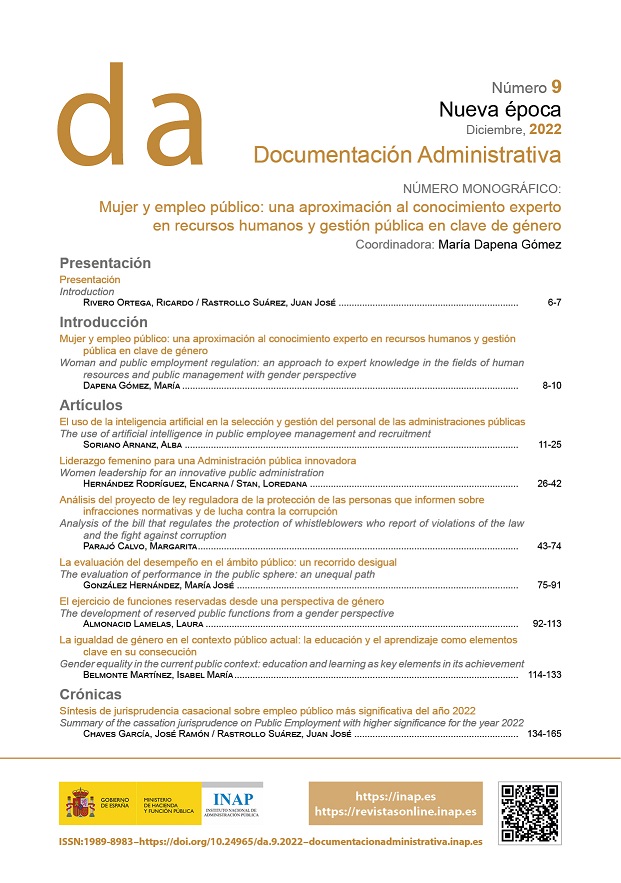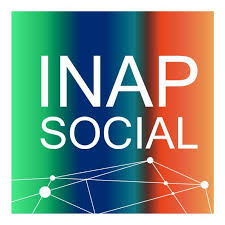Women leadership for an innovative public administration
DOI:
https://doi.org/10.24965/da.11138Keywords:
Innovation, public administration, leadership, equality, womenAbstract
This article focuses on the new leadership formulas that public administration demands in order to address our complex social problems from a collaborative and innovative perspective and based on a gender approach. Thus, starting from the analysis of the position currently held by women in the public sector worldwide and in Spain, the article delves into the differences between the leadership exercised by women and men, and how their attitudes towards innovation and their management fits with today's challenges. The main ideas obtained from the previous theory analysis are contrasted with the vision of five Spanish women public managers, interviewed in depth during the research. The conclusions of the study focus on the new trends in women leadership within the public sector, characterized by "soft" skills that are especially valuable for innovation, as well as the presence of support networks among women that are essential for their promotion and visibility.
Downloads
References
Alsos, G. A., Hytti, U. y Ljunggren, E. (eds.) (2016). Research Hand-book on Gender and Innovation. Edward Elgar Publishing Ltd. https://doi.org/10.4337/9781783478132
Alsos, G. A., Ljunggren, E. y Hytti, U. (2013). Gender and innovation: State of the art and a research agenda. International Journal of Gender and Entrepreneurship, 5(3), 236-256. https://doi.org/10.1108/IJGE-06-2013-0049
Andrews, R., Ashworth, R. y Meier, K. J. (2014). Representative Bureaucracy and Fire Service Performance. International Public Management Journal, 17(1), 1-24. https://doi.org/10.1080/10967494.2014.874253
Backhaus, L. y Vogel, R. (2022). Leadership in the public sector: A meta-analysis of styles, outcomes, contexts, and methods. Public Administration Review, 82(6), 986-1003. https://doi.org/10.1111/puar.13516
Bales, R. F. (1950). Interaction process analysis: A method for the study of small groups. Addison-Wesley.
Bason, C. (2010). Leading public sector innovation: co-creating for a better society. Polity Press.
Bass, B. M. y Avolio, B. J. (1994). Transformational leadership and organizational culture. International Journal of Public Administration, 17(3-4), 541-554. https://doi.org/10.1080/01900699408524907
Bass, B. M. (1998). Transformational leadership: Industrial, military, and educational impact. Erlbaum.
Brettel, M. y Cleven, N. J. (2011). Innovation Culture, Collaboration with External Partners and NPD Performance. Creativity and Innovation Management, 20(4), 253-272. https://dx.doi.org/10.1111/j.1467-8691.2011.00617.x
Brugué, Q. (2022). Organizaciones que saben, organizaciones que aprenden. Instituto Nacional de Administración Pública.
Burke, S. y Collins, K. M. (2001). Gender differences in leadership styles and management skills. Women in Management Review, 16(5), 244-257. https://doi.org/10.1108/09649420110395728
Bustelo Ruesta, M. (2001). La evaluación de las políticas públicas de igualdad de género de los gobiernos central y autonómicos en España: 1995-1999 [tesis doctoral]. Universidad Complutense de Madrid. https://eprints.ucm.es/id/eprint/4513/
Cadoche, E. y De Montarlot, A. (2021). El síndrome de la impostora. ¿Por qué las mujeres siguen sin creer en ellas mismas? Península.
Catalá, R. y Cortés, O. (2020). Administración 2030: una visión transformadora. Propuestas para la próxima década. ESADE/PWC. Recuperado el 31 de agosto de 2022 de https://www.pwc.es/es/publicaciones/sector-publico/assets/observatorio-pwc-esade-administracion-2030.pdf
Crosby, B. C., Hart, P. y Torfing, J. (2017). Public value creation through collaborative innovation. Public Management Review, 19(5), 655-669. https://doi.org/10.1080/14719037.2016.1192165
Damanpour, F. (1991). Organizational innovation: A meta-analysis of effects of determinants and moderators. Academy of Management Journal, 34(3), 555-590. https://www.jstor.org/stable/256406
D’Agostino, M. J. (2015). The difference that women make: Government performance and women-led agencies. Administration & Society, 47(5), 532-548. https://doi.org/10.1177/0095399714548267
De Vries, H., Bekkers, V., y Tummers, L. (2016). Innovation in the public sector: A systematic review and future research agenda. Public administration, 94(1), 146-166. https://doi.org/10.1111/padm.12209
Eagly, A. H. y Johnson, B. T. (1990). Gender and leadership style: A meta-analysis. Psychological Bulletin, 108(2), 233-256. https://doi.org/10.1037/0033-2909.108.2.233
Eagly, A. y Johannesen-Schmidt, M. (2001). The Leadership Styles of Women and Men. Journal of Social Issues, 57(4), 781-797. https://doi.org/10.1111/0022-4537.00241
Evans, M., Edwards, M., Burmester, B. y May, D. (2014). «Not yet 50/50» – Barriers to the Progress of Senior Women in the Australian Public Service. Australian Journal of Public Administration, 73(4), 501-510. https://doi.org/10.1111/1467-8500.12100
Finkel, M., Grøn, C. y Hughes, M. (2021). Moving On Up? Effects of Leadership Training and Intersectoral Mobility on Women’s Advancement in Danish. Public Administration Management. Review of Public Personnel Administration. https://doi.org/10.1177/0734371X211054875
Hernández, E. (2022, noviembre). Lideran, sirven, colaboran, comunican y aprenden: así son las personas innovadoras de la Administración pública. Capital Humano, 380.
Hewlett, S. A., Marshall, M. y Sherbin, L. (2013, diciembre). How Diversity Can Drive Innovation. Harvard Business Review. Disponible en https://hbr.org/2013/12/how-diversity-can-drive-innovation
Hymowitz, C. and Schelhardt, T. D. (1986, 24 de marzo). The Glass-Ceiling: Why Women Can’t Seem to Break the Invisible Barrier that Blocks Them from Top Jobs. The Wall Street Journal, 57, D1, D4-D5.
Isaksson, A., Andersson, C. y Borjesson, E. (2020). Don’t Ask for Ideas and Innovations, Ask for What They Do. Understanding, recognizing and enhancing (women’s) innovation activities in the public sector. Journal of Technology Management & Innovation, 15(2), 95-102. http://dx.doi.org/10.4067/S0718-27242020000200095
Jacobson, W. S., Palus, C. K. y Bowling, C. J. (2010). A woman’s touch? Gendered management and performance in state administration. Journal of Public Administration Research and Theory 20(2), 477-504. https://dx.doi.org/10.1093/jopart/mup017
KANTAR PUBLIC (2021). Gender diversity index of women on boards and in corporate leadership. European Women on Boards – EWOB. Disponible en https://europeanwomenonboards.eu/wp-content/uploads/2022/01/2021-Gender-Diversity-Index.pdf
Klijn, E.-H., Edelenbos, J. y Steijn, B. (2010). Trust in Governance Networks: Its Impacts on Outcomes. Administration & Society, 42(2),193-221. https://doi.org/10.1177/0095399710362716
Laegreid, P., Roness, P. G. and Verhoest, K. (2011). Explaining the Innovative Culture and Activities of State Agencies. Organization Studies, 32(10), 1321-1347. https://doi.org/10.1177/0170840611416744
Lapuente, V. y Suzuki, K. (2017). The Prudent Entrepreneurs. Women and Public Sector Innovation [QoG Working Paper Series, 2017:11]. The Quality of Government Institute. https://gupea.ub.gu.se/handle/2077/54154
Lapuente, V. y Suzuki, K. (2020). Politicization, Bureaucratic Legalism, and Innovative Attitudes in the Public Sector. Public Administration Review, 80(3), 454-467. https://doi.org/10.1111/puar.13175
Lewin, K., y Lippitt, R. (1938). An experimental approach to the study of autocracy and democracy: A preliminary note. Psychometry, 1(3-4), 292-300. https://doi.org/10.2307/2785585
Lowi, T. (1964). At the pleasure of the Mayor: Patronage and power in New York City, 1898-1958. Free Press.
Lowi, T. (1985). The personal president: Power invested, promise unfulfilled. Ithaca.
MCKINSEY & COMPANY (2021). Women in the Workplace 2021 [Report]. Disponible en https://www.mckinsey.com/featured-insights/diversity-and-inclusion/women-in-the-workplace
Meier, K., Mastracci, S. y Wilson, K. (2006). Gender and Emotional Labor in Public Organizations: An Empirical Examination of the Link to Performance. Public Administration Review, 66(6), 899-909. https://psycnet.apa.org/doi/10.1111/j.1540-6210.2006.00657.x
Meier, K. y Nicholson-Crotty, J. (2006). Gender, Representative Bureaucracy, and Law Enforcement: The Case of Sexual Assault. Public Administration Review, 66(6), 850-860. https://doi.org/10.1111/j.1540-6210.2006.00653.x
Moore, M. H. (1995). Creating public value: Strategic management in government. Harvard University Press.
Nählinder, J., Tillmar, M., Wigren, C. (2015). Towards a gender-aware understanding of innovation: a three-dimensional route. International Journal of Gender and Entrepreneurship, 7(1), 66-86. https://doi.org/10.1108/IJGE-09-2012-0051
Nielsen, V. (2014). Personal Attributes and Institutions: Gender and the Behavior of Public Employees. Why Gender Matters to not only «Gendered Policy Areas». Journal of Public Administration Research and Theory, 25(4), 1005-1029. https://doi.org/10.1093/jopart/muu019
Nolan-Flecha, N. (2019). Next generation diversity and inclusion policies in the public service: Ensuring public services reflect the societies they serve [OECD Working Papers on Public Governance, 34]. Organisation for Economic Cooperation and Development – OECD. https://dx.doi.org/10.1787/51691451-en
OECD (2021). Government at a Glance 2021. OECD Publishing. https://doi.org/10.1787/1c258f55-en
OIT (2019). Las mujeres en la gestión empresarial. Argumentos para un cambio. Disponible en https://www.ilo.org/global/publications/books/WCMS_700977/lang--es/index.htm
Orazi, D., Turrini, A. y Valotti, G. (2013). Public sector leadership: New perspectives for research and practice. International Review of Administrative Sciences, 79(3), 486-504. https://doi.org/10.1177/0020852313489945
Orlik, J. (2022, 11 de enero). Four Principles for Orchestrating Innovation Ecosystems. Observatory of Public Sector Innovation – OPSI. https://oecd-opsi.org/blog/four-principles-for-orchestrating-innovation-ecosystems/
Ostrup, N. y Villadsen, A. R. (2014). The Right Mix? Gender Diversity in Top Management Teams and Financial Performance. Public Administration Review, 75(2), 291-301.
Pecis, L. (2016). Doing and undoing gender in innovation: Femininities and masculinities in innovation processes. Human Relations, 69(11), 2117-2140. https://doi.org/10.1177/0018726716634445
Ricard, L. M., Klijn, E. H., Lewis, J. M. y Ysa, T. (2017). Assessing public leadership styles for innovation: a comparison of Copenhagen, Rotterdam and Barcelona. Public Management Review, 19(2), 134-156. https://doi.org/10.1080/14719037.2016.1148192
Rojas-Martín, F. (coord.) (2018). Innovación pública en el ámbito local. Una aproximación a las metodologías y experiencias. Federación Española de Municipios y Provincias. Disponible en https://novagob.org/documentos/innovacion-publica-en-el-ambito-local
Ruiz, S. (2022, 22 de abril). Mujer y liderazgo: la equidad de género como catalizador de resiliencia y competitividad organizacional. Do Better. https://dobetter.esade.edu/es/mujer-liderazgo-resiliencia-competitividad
Ryan, M. K., y Haslam, S. A. (2005). The Glass Cliff: Evidence that Women are Over-Represented in Precarious Leadership Positions. British Journal of Management, 16(2), 81-90. https://doi.org/10.1111/j.1467-8551.2005.00433.x
Smith, A. (2015). On the Edge of a Glass Cliff: Women in Leadership in Local Government. Public Administration Quarterly, 39(3), 484-517. https://www.jstor.org/stable/24773425
Sorenson, R. L., Folker, C. A. y Brigham, K. H. (2008). The collaborative network orientation: Achieving business success through collaborative relationships. Entrepreneurship: Theory and Practice, 32(4), 615-634. https://doi.org/10.1111/j.1540-6520.2008.00245.x
Stan, L. (2022, marzo). Abordar los retos públicos desde los ecosistemas de innovación. Aprendizajes de la experiencia de la Fundación NovaGob [newsletter Ecosistemas abiertos]. Municipalidad de Mendoza. Disponible en https://gaciudaddemendoza.medium.com/abordar-los-retos-p%C3%BAblicos-desde-los-ecosistemas-de-innovaci%C3%B3n-932126d77689
Stivers, C. (1995). Settlement Women and Bureau Men: Constructing a Useable Past for Public Administration. Public Administration Review, 55(6), 522-529. https://doi.org/10.2307/3110343
Tichy, N. M. y Devanna, M. A. (1990). The Transformational Leader. Wiley.
UNDP Y UNIVERSITY OF PITTSBURGH (2021). Gender equality in public administration [global report]. UNDP – University of Pittsburgh. https://www.undp.org/publications/global-report-gender-equality-public-administration
Van Acker, W., Wynen, J. y Op de Beeck, S. (2018). Illuminating the Gender Divide in Public Sector Innovation: Evidence From the Australian Public Service. Public Personnel Management, 47(2), 175-194. https://doi.org/10.1177/0091026017747299
Van Keer, E. y Bogaert, J. (2009). Decoding the DNA of Public and Private Sector Leaders. Hudson. Disponible en https://www.criticaleye.com/inspiring/insights-detail-new.cfm?id=1887
Wynen, J., Verhoest, K., Ongaro, E. y Thiel, S. (2014). Innovation-oriented culture in the public sector. Public Management Review, 16(1), 45-66. https://doi.org/10.1080/14719037.2013.790273
Downloads
Published
How to Cite
Issue
Section
License
Copyright (c) 2023 Documentación Administrativa

This work is licensed under a Creative Commons Attribution-NonCommercial 4.0 International License.













